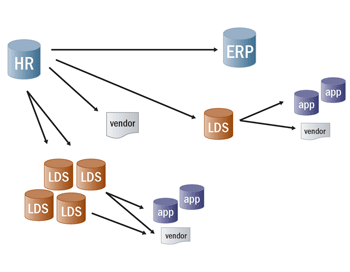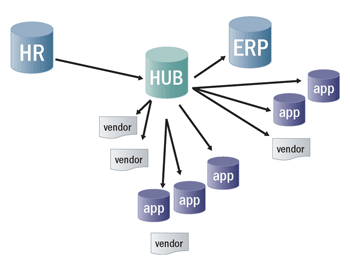CASE STUDY - Seagate Technology Improves Data Consistency and Eliminates Manual Coding
Commentary by Carin Komer, HR Data Hub Program Manager, Seagate Technology
The Challenge
Seagate Technology is the world’s leading manufacturer of hard disk drives for enterprise, consumer, desktop, and mobile systems. With more than 44,000 employees in seven countries across Asia, North America, and Europe, an effective human resources data infrastructureis vital to Seagate’s ability to manage personnel acquisition, compensation, and benefits across the globe. Seagate recognized the need for a next-generation HR data infrastructure—an HR data hub—that would reduce integration costs, improve data consistency across multiple units, enhance data availability,and provide cost-effective flexibility.
Over more than a decade, Seagatehad knitted together an HR patchwork of legacy and third-party outsourced applications for such HR business functions as payroll, benefits, headcount, stock options, and more. As Seagate’s HR system of record, an Oracle HRMS application feeds five localized legacy data stores (homegrown and packaged software atop Oracle databases), which in turn feed more than 100 downstream applications around the world.
Seagate struggled to maintain more than 100 custom-coded integration touch points between multiple data stores and a blend of homegrown and packaged downstream applications. The company bore a high cost burden to maintain this intricate system with custom SQL coding, and time-consuming development chores often resulted in a backlog of work for Seagate’s human resources information technology (HRIT) developers and frustration for business users.
As applications were added, updated, or removed, inherent problems with inconsistent data and redundant extraction logic multiplied. In addition, the system took up to 48 hours to reflect new information to end users—an unacceptable time lag in a fast-moving global marketplace.
To reduce costs and streamline HR data distribution, Seagate envisioned an HR data hub that would:
- Slash time and costs of custom-coded SQL integration
- Improve data consistency across multiple systems
- Reduce Oracle HRMS integration touch points from many to one
- Accelerate data distribution and reduce latency
- Enable legacy systems retirement to reduce operational costs

Figure 1. The complex legacy point-to-point HR data infrastructure was difficult and expensive to manage.
The Solution
Seagate recognized an opportunity to capitalize on its success using Informatica® PowerCenter® for data warehousing by extending PowerCenter into the operational arena to execute complex data integration among the myriad enterprise applications requiring HR data. Seagate envisioned a concept similar to the customer data hub, designed to create a single view of a customer by integrating information from disparate sources.
Seagate chose PowerCenter for its proven ease of use, mapping templates, and reusability of definitions across projectsand platforms. A fast learning curve was particularly important. Although Seagate had highly skilled SQL developers and Oracle database administrators, none of its 10 team members had experience with PowerCenter.
Moreover, Seagate had set an aggressive six-month timeline to go live with the first phase of its data hub and had no budget for external consultants. With a globally distributed development team, Seagate could not afford months of training for its programmers to master a complex tool.
In February 2005, Seagate embarked on a four-phase project that would replace the complex point-to-point data integration network with a single data hub based on the Oracle 9i database. PowerCenter would be deployed to serve two integration functions: 1) extract data from the Oracle HRMS system of record application into the Oracle 9i data hub, and 2) distribute data from the hub to more than 100 downstream applications.
Secure Data Infrastructure
Seagate took advantage of code and version control, migration management, group/ folder permission standards, and other PowerCenter security features in building a three-tier integration environment consisting of development, testing, and production. With PowerCenter’s component-based reusability, 4.8 full-time equivalents (FTEs) collaborated on parallel activities across the three tiers, including defining data models, installing the development and test environments, and developing hub and interface mappings.
The compartmentalized approach enables Seagate to govern who has access to what code and data to protect employee privacy, abide by best practices in the COBIT IT governance framework, and provide auditability to meet Sarbanes- Oxley and other regulatory requirements.
Enhanced Performance
The team customized a PowerCenter template to build in granular field-level change detection, by which PowerCenter would extract and move only data that had been changed since the prior mapping run. In the development environment, the reduced data volumes enabled by field-level change detection slashed load time from 2.5 hours to 15 minutes compared to previous time/date detection techniques,and minimized performance impact on source, targets, and the Seagate network.
Rapid Deployment
In less than six months—on time and within budget—Seagate went live with the first phase of its HR data hub deployment, covering 10 downstream applications. As it progresses through three additional phases in 2006, Seagate will have consolidated into its HR data hub roughly 100 integration touch points, and virtually eliminated the expensive SQL coding needed to adapt and maintain the proliferation of integration points.
“With PowerCenter, we’re able to replace a high-maintenance legacy infrastructure with a high-performance data hub that improves HR data consistency across the globe,” said Carin Komer, HR data hub program manager. “We’ll save about $1.2 million over three years just by eliminating all the manual SQL maintenance and development chores of the old system.”

Figure 2. Streamlined data hub built on PowerCenter saves development and maintenance costs and provides extensibility for future growth.
The Results
Projected $1.2 Million Savings in Development and Maintenance Costs
Over three years, Seagate HR IT estimates it will save $1.2 million in development and maintenance costs previously spenton custom SQL coding across its complex and disparate integration touch points.It also expects significant cost savings through the retirement of legacy HR systems in the U.S. and Asia, reduction in change request backlogs, and a standardized integration environment that fosters shared skills among developers and helps eliminate reliance on specialized skills.
Enhanced Data Availability andSystems Performance
With PowerCenter orchestrating integration between the data hub and source and target applications, Seagate is exponentially improving the availability of data to the more than 100 target applications and their business users. With the legacy system, data was extracted from the Oracle HRMS application just once a day, and it took up to 48 hours to reach the downstream targets. PowerCenter now executes four data transfers per day from Oracle HRMS to the data hub, each in less than 10 minutes. And it delivers data from the hub to downstream targets between one and four times a day (according to business needs), so that information is updated in as little as two hours. For instance, it makes a stock plan application available to new employees within six hours of their hire.
Improved Data Consistency and HR System Efficiency
In the past, the five localized data stores that routed information from the Oracle HRMS application applied varying transformations before distributing thedata to downstream applications. The result was differing data semantics and definitions across the downstream network, with discrepancies in headcount and other problematic issues. The PowerCenter-driven data hub eliminates the problem by applying a common set of transformations to all HR data before distribution and helps ensure the efficiency and accuracy of HR systems, as well as workforce productivity.
Ensured Extensibility for Future Growth and Changing Needs
The flexibility inherent in PowerCenter positions Seagate to rapidly respond to changing IT and business demands and fully leverage its global development resources. For instance, the central HR data hub may be readily extended to accommodate new business applications or additional outsource vendors.
This article originally appeared in the issue of .